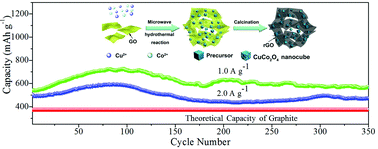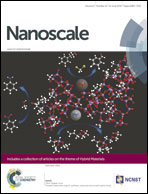Porous CuCo2O4 nanocubes wrapped by reduced graphene oxide as high-performance lithium-ion battery anodes†
Abstract
A composite of porous CuCo2O4 nanocubes well wrapped by reduced graphene oxide (rGO) sheets has been synthesized by a facile microwave-assisted solvothermal reaction and applied as anode in lithium ion batteries (LIBs). The porous structure of the CuCo2O4 nanocubes not only provides a high surface area for contact with the electrolyte, but also assists by accommodating volume change upon charging–discharging. Impedance measurements and transmission electron microscopy show that incorporation of rGO further decreases the charge transfer resistance and improves the structural stability of the composite. As an anode material for a LIB, the composite exhibits a high stable capacity of ∼570 mA h g−1 at a current density of 1000 mA g−1 after 350 cycles. With a high specific surface area and a low charge transfer resistance, the composite anode shows impressive performance especially at high current density. The LIB shows a high capacity of ∼450 mA h g−1 even at a high current density of 5000 mA g−1, demonstrating the composite's potential for applications in LIBs with long cycling life and high power density.


 Please wait while we load your content...
Please wait while we load your content...